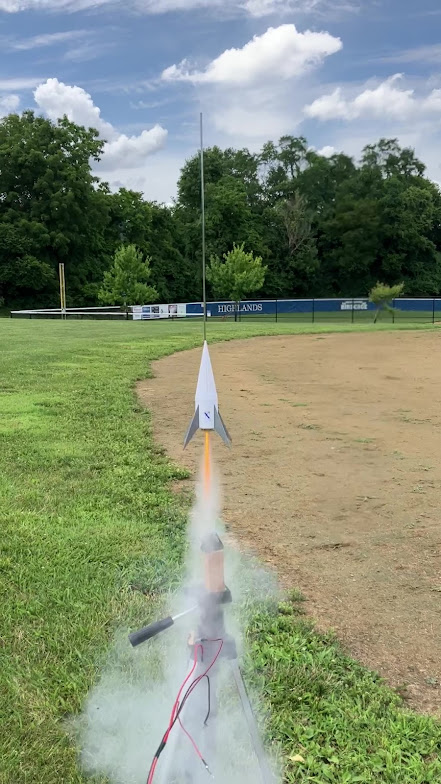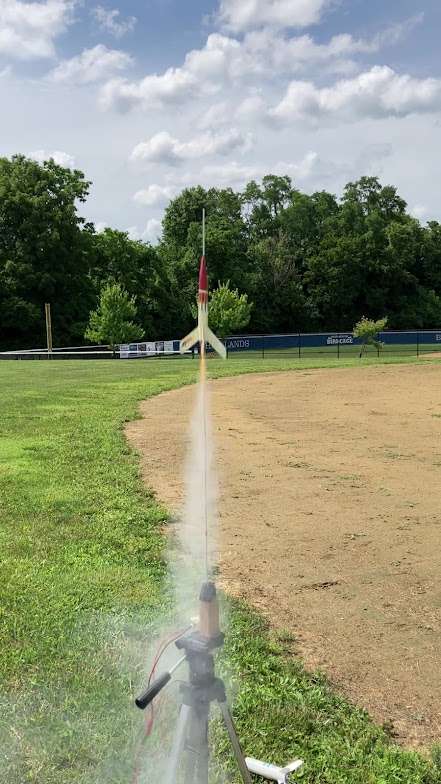This was a surprise launch. We were scheduled to fly on Saturday, but I was going to miss because of a 60th birthday party and goat herding for one of my buds. As luck would have it, the wind forecast would cause for the cancellation of the Saturday launch and a move to a Sunday launch. The second Sunday is usually the day we meet with friends to do breakfast, but as of Saturday no one had given breakfast a thought, so no plans were made. HUZZAH! I was clear for launch on Sunday. BUT WAIT!!!! My wife decided to take the ball and run with it and sent out the email. Soon we had a 10am table for us and four friends. I didn't complain. It meant I'd get goetta for breakfast. "Peanut butter box is here."
So, after a Ham and Swiss Fritatta with green onions, I headed to the field a little before noon. This meant it would be after 1pm before I got flying, but goetta, remember? There had already been a CATO before I arrived, so at least I wouldn't have to provide that. As it was, I had other contributions to make.
My last WSR launch back around Father's Day had been something of a farce. I brought home a lot of damaged birds and another that never left the pad after lighting only one motor. Even before I left for the field, I knew that my first flight of the day would be the USS Atlantis with the FlisKits canted cluster. It owed me.
Don't get too fired up. It looked great on the pad back in June, too. That said, this would not be a second failure. Flying on a 2xC6-5 load, the Atlantis hit all the marks. It left the pad without impingement, stayed oriented to show the flightline the Michael Schenker smoke trail, and landed without breaking off one of the tubes. The flight was almost dead straight to around 500', ejecting as it was still moving forward somewhat, and starting swinging like a pendulum as it recovered. It landed softly in the grass to the right of the high-power pads. It was a great start. I should have seen trouble lurking.
Trying to keep my hot streak going, I chose a never before flown, unpainted rocket that I almost forgot when packing, the PemTech Kraken. I actually had it prepped for another launch that hadn't worked out, so it had been sitting in an out of the way spot when I was gathering my victims at 7:30am. The only reason I found it was because I was looking for my parachute case. As it was, I found both.
All I know about the Kraken is what I've read in reviews. I built mine to be E-motor capable, but not seeing a whole lot of E-motor flights listed, I chose to go with a D12-5 in the shakedown flight. Like the Atlantis, the Kraken boosted quite straight to around the 500' mark. Unlike the Atlantis, it then drifted away from us across the soccer field, really looking like it was heading to the creek or the corn. I began walking after it almost immediately, and was about to see it land at the far edge of the last soccer field by the creek, corn and road. One final gust could have sent it to any of the three, so I counted my blessings and helped another flyer who wasn't quite as lucky. His had not only cleared the soccer field, but had landed on the bridge in traffic. It was recovered with slight road rash, but who doesn't have some of that.
Flight #3 would end my lucky streak. I had been trying to decide on a color combination for the T.H.O.Y. Wren for quite a while. I had previously flown it 8 years ago in a red and black combination, but hadn't really liked how those colors looked together. I tried gold and black earlier this year, but that didn't grab me either. I recently picked up another red and black combination that I really liked, and it was this one that came to the field with me on this day.
This would be the first flight since 2015, all because of mud and paint issues, but I was pretty pumped about it. The Wren was a sturdy and stable performer back in 2015, and I expected nothing less in 2023. The flight itself was perfect, an E12-6 out away from the flightline that flirted with 800'. It ejected a lot early, but I didn't anticipate that being an issue and we watched it drift onto the soccer property.
The scene that greeted me at the recovery zone was a shock. The soccer complex has a lot of grass, but also an access road and some reclaimed asphalt parking pads. The access roads are gravel, but they're hard packed, so anything that lands on them is guaranteed some kind of fin damage. I got the deluxe package. The Wren had hit the access road. One fin was laying at the point of impact, jaggedly snapped off and not repairable. Another fin was cracked along the fillet and part of the tip had been chewed away. Even the "undamaged" fin had road rash. At the moment I'm undecided as to what I'm going to do with it going forward.
I only had two flights of unflown birds on this day, (although I had several others in the car ready to go.) The Kraken was the first. The Estes Warp II was the second. My brother-in-law had one that he found in a salvage store years ago, (along with an FSI Hercules and a LOC Lil' Nuke.) It had been built as a single stage bird and the paint looked like nail polish. Still, it was a cool looking bird and a decent flyer. Mine is pretty standard, and two stage as intended.
I chose a B6-0/B6-6 combo for the first flight, just to be on the safe side. I thought about flying it at B6-4 Field, but things are a little tight for unpredictable staged flights. Good thing. The Warp II left the pad boosting fairly straight, but began drifting left when the breeze caught the big fins. The slight delay during staging and the breeze combined to cause the sustainer to arc back over the flightline considerably. The normal flight setup at B6-4 Field would have put the sustainer in the trees at the top of the hill. At eRockets field it just meant that it was over another baseball field, and it recovered safely in home run territory.
Another old vet that hadn't seen flight time since 2015 would be on the pad for flight #5. The first flight of the Shrox Skonk Wulf had resulted in a wiggly flight path that obviously needed nose weight. It took me eight years, but I finally had it ready for a second flight.
The E12-6 flight benefitted greatly from the added nose weight. It left the pad arcing out toward the soccer fields, but with only one or two slight wiggles, a vast improvement over the previous flight. That one had been borderline unstable and looked ready to cross the border at each flip of the tail. The Wulf ejected nice and easy out to the right of our high-power pads, then began following the breeze into the soccer complex. It bounced on impact, but not violently, so I still had hope of no damage. When I reached the landing site my hope was dashed. One of the small wing-tip fins had broken off along the glue joint. An easy fix, and hopefully the next flight will have paint and decals. Check back in 2031.
The next flight hurt. I'd just finished cutting and replacing a fin lost on the last flight of my Estes Sentinel, a clone made using Excelsior decals. It hadn't been repainted yet because I was trying to figure how to mask it without sacrificing the other decals, but it was flightworthy again, so I thought I'd give it some flight time. The original was an 18mm powered bird, but since mine was a clone, I went with 24mm power. This flight would be on a D12-5, a pretty standard flight on a field of this size.
This flight started out looking great. It left the pad almost dead straight to around 800'. We counted off the delay and looked expectantly for the bright green chute. Nothing. The whole flightline was still looking skyward for the chute off to the left of the pads when one of the spectators mentioned that it had come down on the ballfield behind us. This confused everyone on the flightline as it was way too quick for it to have come down. Maybe I was slow on the uptake. I walked behind the flightline and sure enough, the Sentinel sat in the middle of the ballfield, but I didn't see the bright green chute anywhere. I checked the sky to see if it was floating away and saw nothing. All the while I was walking toward the landing zone, and when I reached the fence, the horrible truth dawned on me. Suddenly I could see the bright green parachute, only I could see it through the side of the body tube. And the nose cone was sticking straight out of the ground. I knew from experience that this was not good. Postmortem showed that there had been an ejection event, but with only a small portion of the clay cap gone from the D12-5, it hadn't been much of one. The nose cone pulled from the ground undamaged, but took a pretty good pull to do so. The Sentinel was crushed from tip to just below the top ends of the strakes. Essentially, I have a nose cone and a fin can if I decide to rebuild. The jury has not yet returned on that possibility.
The next bird on the pad had once experienced an odd ejection charge of its own. The Viking IV is an upscale of the FSI Fiking IV from back in my king size days. I had become interested in the Viking lineup after Bill Saidon introduced the Viking 1 as a BMS Clone of the Month. Bill's was a 1:1 clone, and I actually built the Viking III and V that way, but for some reason I decided to go big on the Viking II and IV. While flying with my brother-in-law and the Tri City Skybusters up in Amherst, Ohio, the Viking IV was carrying a keychain camera and flying on an E9-4. The ejection charge sounded mammoth from the flightline and a separation was noted. The body came in ballistic and landed hard to the left of the flightline, while the nose cone and parachute came down directly in front of us. The body tube was crushed to the point that I had to cut away 6 to 8" from the top. When I retrieved the nose cone and parachute, I also found the ejection baffle. The force of the ejection charge had been enough to blast away two king sized glue fillets. The keychain camera had filmed the whole flight and recovery, and you can hear the ground approaching just before the picture cuts out. Terrible flight, but in a weirdy entertaining way. A shorter Viking IV would be the one that came to the pad for flight #7 on the day.














































































